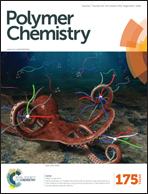POSS semitelechelic Aβ17–19 peptide initiated helical polypeptides and their structural diversity in aqueous medium†
Abstract
Biomolecule promoted helical polypeptides and their structural diversity towards external/internal stimuli is an interesting research area to the material science community. In this report, we have synthesized sequence registered peptide–polypeptide conjugates via ring opening polymerization (ROP) of γ-benzyl-L-glutamate N-carboxyanhydride (BLG-NCA) employing two amine terminated peptide initiators, namely H-Phe-Val-Leu-POSS (POSS: polyhedral oligomeric silsesquioxane; Leu: leucine; Val: valine; Phe: phenylalanine) and H-Phe-Val-Leu-OMe. Main chain POSS semitelechelic or POSS free tripeptide containing poly(γ-benzyl-L-glutamate) (PBLG) homopolymers adopted α-helical conformation in both solution and the solid state, because of intramolecular hydrogen bonding and π–π aromatic interactions between side chain phenyl groups. POSS/OMe tripeptide conjugated PBLG segments self-assembled into hierarchical ordered helical entangled nanofibres, revealed by tapping mode atomic force microscopy (AFM) and field emission-scanning electron microscopy (FE-SEM). Expulsion of side chain benzyl groups (crucial for π–π aromatic interaction and stabilizing groups for the secondary structure scaffold) produced pH-sensitive amphiphilic anionic homopolymers, which exhibited diverse self-assembled nanoparticles in aqueous medium at pH 8.0. Interestingly, a morphological switch from sphere to square shaped micelles could be achieved simply by adjusting the net fraction of POSS moiety and/or the length of the benzyl deprotected segment.


 Please wait while we load your content...
Please wait while we load your content...